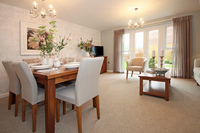Stamping down on stamp duty

Fenton Hewitt, Sales Director for Barratt Homes North East explains how the changes to stamp duty will affect Newcastle homebuyers.
Many homebuyers are not fully aware of stamp duty when purchasing their first home and it can come as quite a nasty surprise and something they have not budgeted for. However, recent changes to the stamp duty land tax, which came into effect on December 4th, mean that a whopping 98% of homebuyers will now pay less. The changes, which represent another move by the government to stimulate the housing market, will make it easier for first-time buyers to take their first steps onto the property ladder. Here’s a take on what the new system means for you.
In short, stamp duty is a one-off tax you have to pay when you complete the purchase of a property. The legislation dates all the way back to 1694, during the reign of William and Mary, who required financial support for their war campaign in France. Today, it goes to the HMRC, who process a certification of ownership upon receipt of the stamp duty. You cannot buy a home without paying this fee.
Up until this December, we have been using what some have called a ‘slab’ system. The old formula meant you were charged 1% of the price of the property, between £125,001 and £250,000, 3% between £250,001 to £500,000, 4% between £500,001 to £1,000,000 and so forth. Notice that crucially, these percentages apply to the entire value of the property.
For example, in the past, a house at £200,000 would be taxed at 1% so you would pay £2,000 in SDLT (Stamp Duty Land Tax). The problem with this system is the crossover areas - the categorical bands lead to discrepancies and distort the market.
For example, a house at £250,000 would be taxed at 1% so you’d pay £2,500 in SDLT, but a house at £260,000 would be taxed at 3% with an SDLT total of £7,800.
It’s not hard to see why the government has chosen to reform stamp duty when paying £10,000 more on a house could cost you an extra £5,300.
Thankfully, the government has addressed this issue and the new system echoes the UK’s approach to income tax bands, ensuring that the amount of tax due rises incrementally with regard to the value of the property. That is achieved through a more progressive system, in which taxes are paid per band, as opposed to the old system, where the overall sale price is taxed at a flat rate.
For example, a house at £200,000 is now taxed at 0% for the first £125,000 and 2% for the remaining £75,000 so you’d pay just £1,500 stamp duty, a saving of £500 on the previous system. If your house costs £250,001 to £925,000, you will pay 0% for the first £125,000 and 5% of the rest of the property will go towards stamp duty.
Most importantly, these changes spell the end of bracketed pricing on houses, freeing up developers and real estate agents to sell homes at a price that accurately represents the value of the property, rather than estate agents manoeuvring valuations around an irrationally tiered system.
In the new system, homebuyers looking at properties in the £260,000 range will make a saving of £4,800 in stamp duty. A considerable incentive, alongside Help to Buy, which gives people the opportunity to buy a new build property with a deposit as little as 5% and offers an equity loan of 20%, which is only repayable after five years.
This move has cleared up the dead zones in house prices. Previously, pricing was tactically placed around the tax brackets – with a lot of developers wary of exceeding the £250,000 mark because of the ridiculously sharp rise in stamp duty. Experts are predicting that a sweet spot will now arise between £250,000 and £280,000 where the 5% band only applies to the amount in the third bracket £250,000. People looking at properties in this price mid-range are undoubtedly the big winners of the new legislation.
To give an example of the difference the new system will make for those looking to buy a new property, Barratt Homes’ new developments, Riverside Crescent in Blaydon and Lakeside View in Killingworth, with properties ranging from £156,995 to £259,995 - offer a wide range of terraced, semi-detached and detached houses.
At the more affordable end of the Riverside Crescent development, the Dewsbury model - a three bedroom’ semi detached home - is available for £156,995. Thanks to the new system, stamp duty on a property of this price has been reduced by £930.05 to just £639.90. With a 5% Help to Buy deposit of as little as £7849.75, the upfront cost of the property has been slashed by the new legislation, making new homes in the area more affordable.
These changes to stamp duty land tax are well timed; with a recent study by a leading international estate agent predicting a 25.7% increase in house prices by 2018 . The new legislation – along with the extended Help to Buy scheme - could act as a springboard for the sale of new homes before house prices and interest rates start rocketing up.
To find out more about Barratt Homes in the North East, visit barratthomes.co.uk.

